MARIANI’S
Virtual
Gourmet
October 10,
2021
NEWSLETTER
Founded in 1996
ARCHIVE

"The Kitchen Maid at the Supper at Emmaus" by Diego Velasquez (1618)
IN THIS ISSUE
The Tastes of James Bond
Part Two
By John Mariani
NEW YORK CORNER
THE LEOPARD AT DES ARTISTES
By John Mariani
CAPONE'S GOLD
CHAPTER 28
By John Mariani
NOTES FROM THE WINE CELLAR
BURGUNDY'S 2021 VINTAGE
By John Mariani
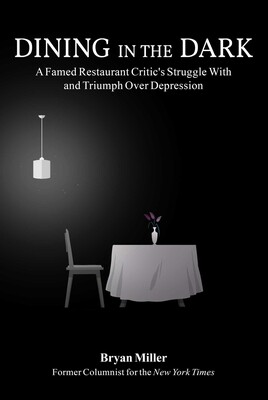 former restaurant critic of the NY
TImes and author of the new book, Dining
in the Dark. Go to: WVOX.com.
The episode will also be archived at: almostgolden.
former restaurant critic of the NY
TImes and author of the new book, Dining
in the Dark. Go to: WVOX.com.
The episode will also be archived at: almostgolden.
By John Mariani
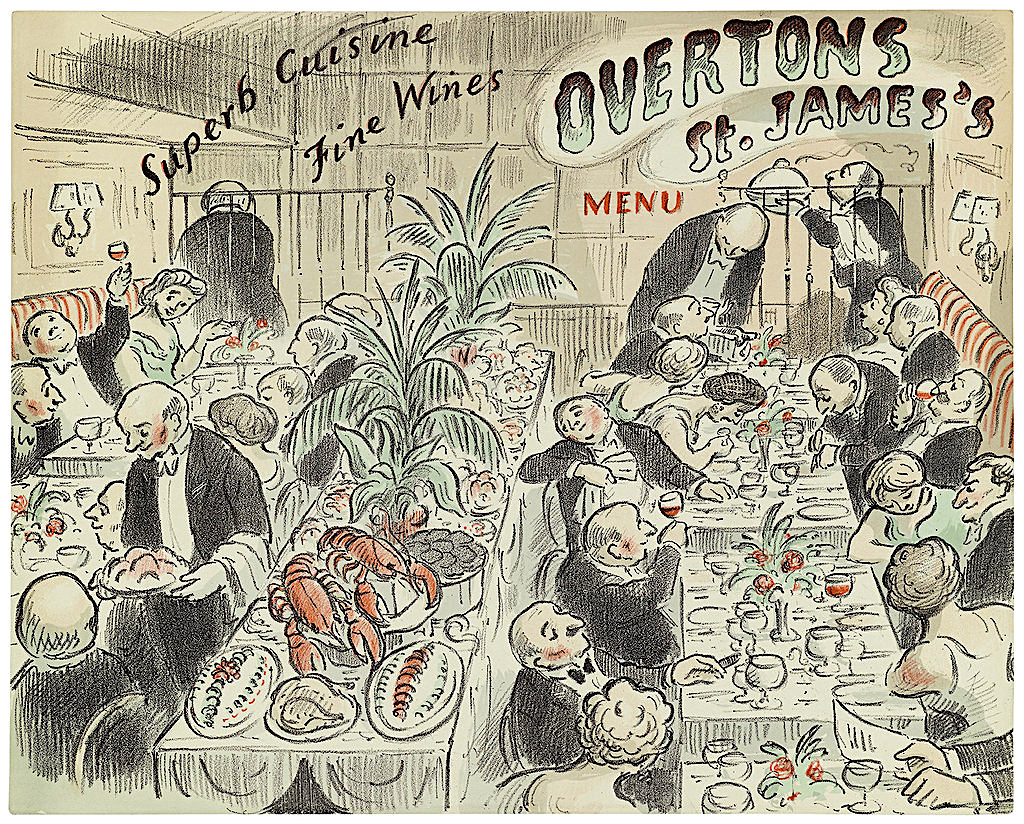
As noted last week, the imminent opening
of the new James Bond movie
with the awkward title No Time to
Die
is the last with Daniel Craig as 007, who, unlike
his predecessors, has shown
little interest over five films in food, wine and
spirits, 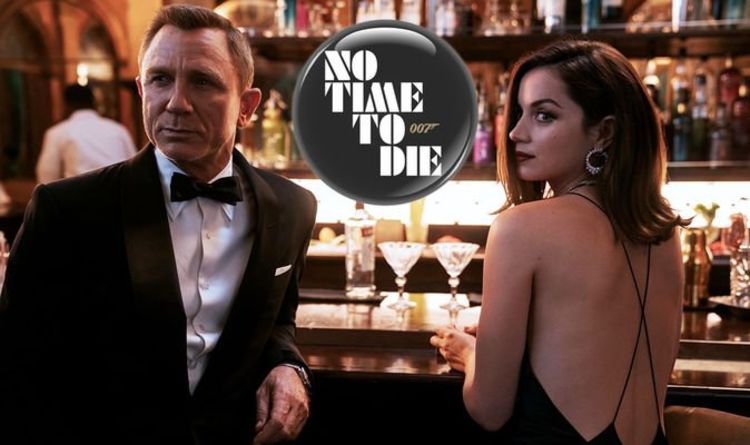 beyond ordering
Bond’s famous vodka Martini. In this, Part Two, of
my assessment of the British
agent’s tastes, as detailed in both the 15
original Ian Fleming novels and the
25 films to follow, will give some general
information on Bond’s preferences in
the novels, which were all written during the Cold
War and reflect the tastes
and mores of the period. In coming chapters (to
appear intermittently) I will
treat each of the individual books and movies,
which often have little to do
with each other.
beyond ordering
Bond’s famous vodka Martini. In this, Part Two, of
my assessment of the British
agent’s tastes, as detailed in both the 15
original Ian Fleming novels and the
25 films to follow, will give some general
information on Bond’s preferences in
the novels, which were all written during the Cold
War and reflect the tastes
and mores of the period. In coming chapters (to
appear intermittently) I will
treat each of the individual books and movies,
which often have little to do
with each other.
Bond drinks a good deal but is never drunk on
a mission. His preferred
beverages are a Martini, of course, and Champagne,
which in the early novels is
Taittinger Blanc des Blancs. He’s not much of a wine
drinker, and on one
occasion, at the private club Blades, spurns his 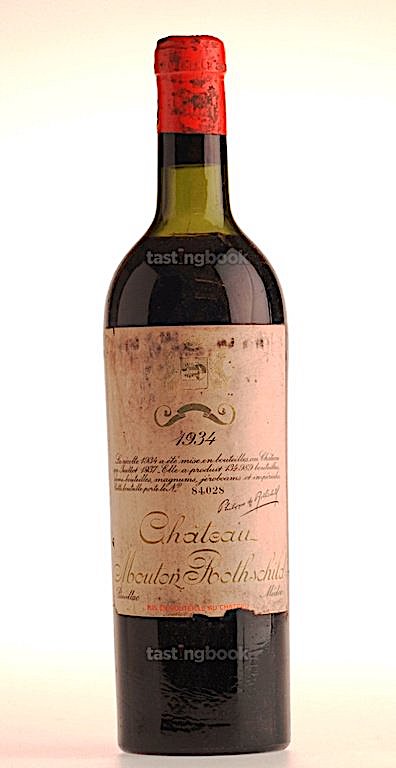 superior
M’s service of a
Premier Cru Mouton-Rothschild ‘34, saying he prefers
a Taittinger ’45, which he
calls “a fad of mine.” On other occasions, when he
himself orders red wine, it
is usually Mouton.
superior
M’s service of a
Premier Cru Mouton-Rothschild ‘34, saying he prefers
a Taittinger ’45, which he
calls “a fad of mine.” On other occasions, when he
himself orders red wine, it
is usually Mouton.
Bond is willing to try new drinks, as when
CIA colleague Felix Leiter
pours him an Old Fashioned cocktail made with Old
Grand-Dad bourbon. Bond never
drinks Port or Sherry, however. Nor is he
particularly fond of beer, but drinks
a Red Stripe in Jamaica and a Löwenbrau in Geneva.
Beefeater or Gordon’s are
acceptable gins, but, of course, 007 made vodka
famous with his Vesper Martini,
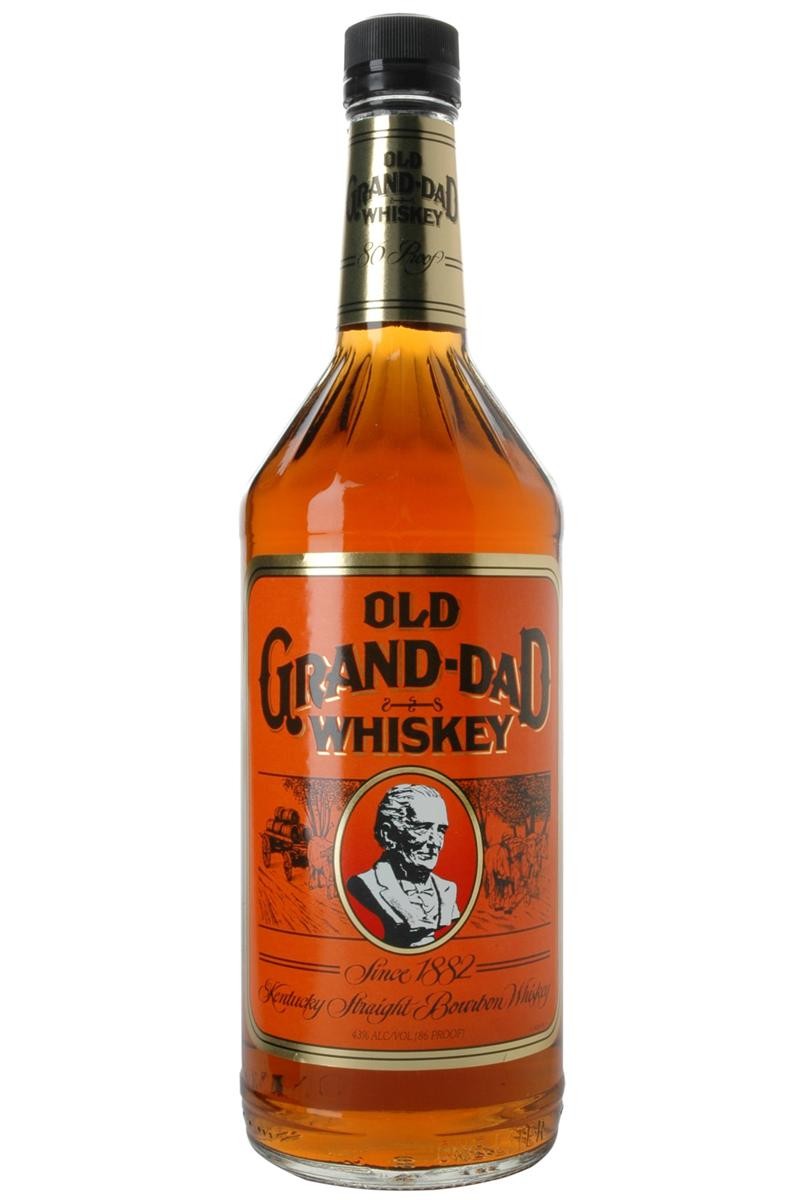 requesting
Stolichnaya (which in the 1950s and 1960s was
unavailable outside of
Russia, where Bond once served on missions) but
happy with Wolfschmidt.
requesting
Stolichnaya (which in the 1950s and 1960s was
unavailable outside of
Russia, where Bond once served on missions) but
happy with Wolfschmidt.
Bond
does not consider himself a
connoisseur in the books, instead eating and
drinking what he likes, based on
worldly experience with the best of everything. In
the films, as we shall see,
he is far more likely to strut his knowledge of wine
and spirits in
exceptionally arcane ways. In the books Bond takes
real pleasure in his meals
as restoratives and times of relaxation, so he
usually orders comfort food on
his own. Only when he is on a mission, with an
unrestricted expense account,
does Bond really indulge in more lavish meals,
usually while seducing the next
beautiful woman he’s met, who rarely possesses even
a little little of Bond’s
acumen about food and wine.
When at home in London (he lived in Chelsea
on Wellington Square), his
breakfast is invariably scrambled eggs with bacon or
sausage; sometimes he’ll
add Scottish smoked salmon. He drinks strong coffee
from ground beans purchased
at De Bry de Paris on Oxford Street,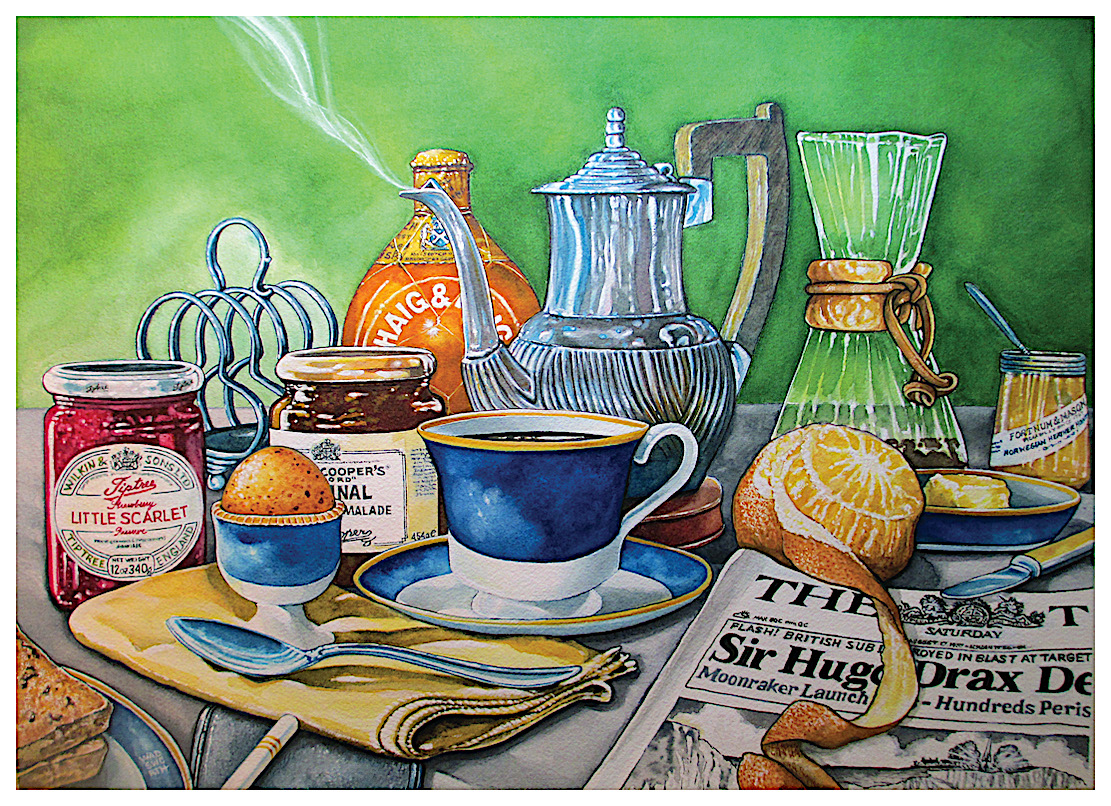 brewing it in a Chemex percolator. Bond hates
tea, which he describes as “a
flat, soft, time wasting opium of the masses.”
brewing it in a Chemex percolator. Bond hates
tea, which he describes as “a
flat, soft, time wasting opium of the masses.”
007 adores caviar, Russian beluga—“The
trouble always is not how to get
enough caviar, but how to get enough toast with it,”
he says, sounding both
prissy and pedestrian at the same time—which he buys
at Fortnum & Mason in
Piccadilly, where he also gets his Tiptree “Little
Scarlet” strawberry
jam, Cooper’s
Vintage Oxford Marmalade
and Mount Hymetus honey.
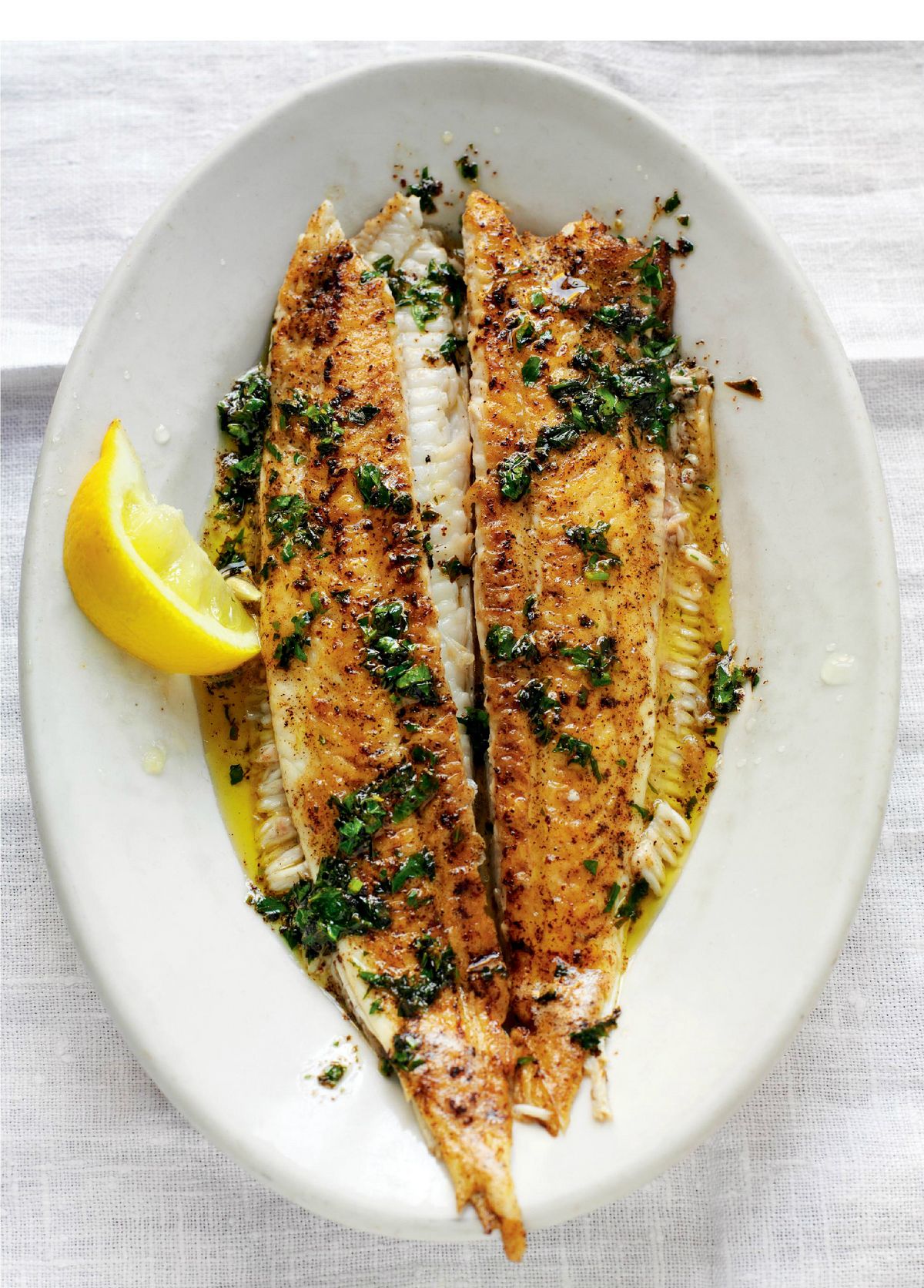 When he has the
pleasure of dining alone, Bond eats quite simply,
most
often on filet of sole (left)—he never
specifies it be Dover—with some Champagne or
wine. If he’s in Italy, his choice is a well-made
spaghetti alla
bolognese. He is open to new
flavors, as when he dines with Tiger Tanaka in
Japan, but generally his taste
in food is that of an average, sophisticated,
well-travelled English gentleman
who feels most at home ordering from a good hotel
menu in London or Paris. Once
in a while that
When he has the
pleasure of dining alone, Bond eats quite simply,
most
often on filet of sole (left)—he never
specifies it be Dover—with some Champagne or
wine. If he’s in Italy, his choice is a well-made
spaghetti alla
bolognese. He is open to new
flavors, as when he dines with Tiger Tanaka in
Japan, but generally his taste
in food is that of an average, sophisticated,
well-travelled English gentleman
who feels most at home ordering from a good hotel
menu in London or Paris. Once
in a while that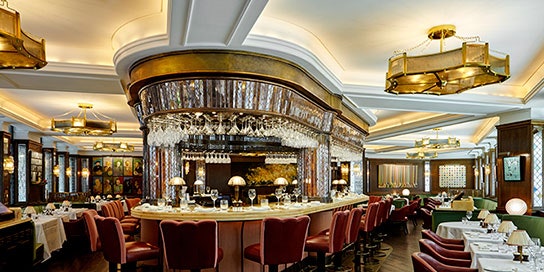 might be at someone
else’s private club or at one of those
restaurants frequented by his creator, Ian Fleming,
who listed his own
favorites in the April 1956 issue of Holiday
Magazine. They included The Ivy (right),
which has long been a celebrity restaurant in
Covent Garden, where he announced to a friend he had
written “the spy story to
end all spy stories.”
might be at someone
else’s private club or at one of those
restaurants frequented by his creator, Ian Fleming,
who listed his own
favorites in the April 1956 issue of Holiday
Magazine. They included The Ivy (right),
which has long been a celebrity restaurant in
Covent Garden, where he announced to a friend he had
written “the spy story to
end all spy stories.”
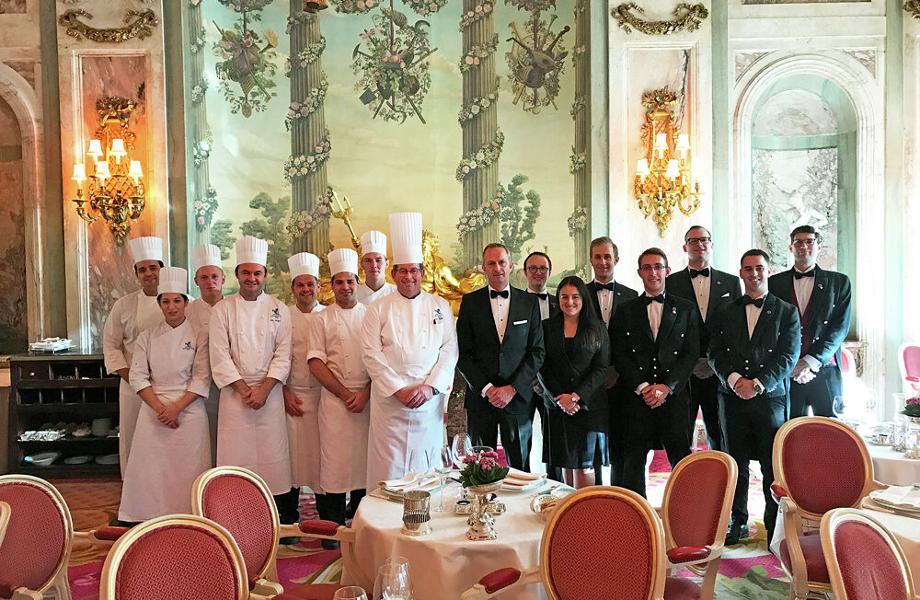 Fleming,
who had himself worked for the British secret
service during
the war, later wined and dined a Polish spy named
Kystyna Skarbek (the model
for Vesper Lynd of Casino Royale)
at
Bertorelli’s on Charlotte Street, opened in 1913
(there was another Bertorelli's
in Covent Garden).
The even older
L’Étoile (below), also on Charlotte Street,
was one of the novelist’s favorites
in Fitzrovia during the war. Wilton’s,
originally on Bury Street then moved to Jermyn
Street, was where he went when
feeling posh
Fleming,
who had himself worked for the British secret
service during
the war, later wined and dined a Polish spy named
Kystyna Skarbek (the model
for Vesper Lynd of Casino Royale)
at
Bertorelli’s on Charlotte Street, opened in 1913
(there was another Bertorelli's
in Covent Garden).
The even older
L’Étoile (below), also on Charlotte Street,
was one of the novelist’s favorites
in Fitzrovia during the war. Wilton’s,
originally on Bury Street then moved to Jermyn
Street, was where he went when
feeling posh  and in the mood for good
British cooking, and, of course, he loved
the elegance of the nearby Ritz Grill (left).
Scott’s on Coventry Street (also
relocated) was the place for seafood, where he tried
to get two German POWs
drunk to reveal information. Bond invites his
colleague Bill Tanner to Scott’s
(below) in Diamonds Are
Forever.
and in the mood for good
British cooking, and, of course, he loved
the elegance of the nearby Ritz Grill (left).
Scott’s on Coventry Street (also
relocated) was the place for seafood, where he tried
to get two German POWs
drunk to reveal information. Bond invites his
colleague Bill Tanner to Scott’s
(below) in Diamonds Are
Forever.
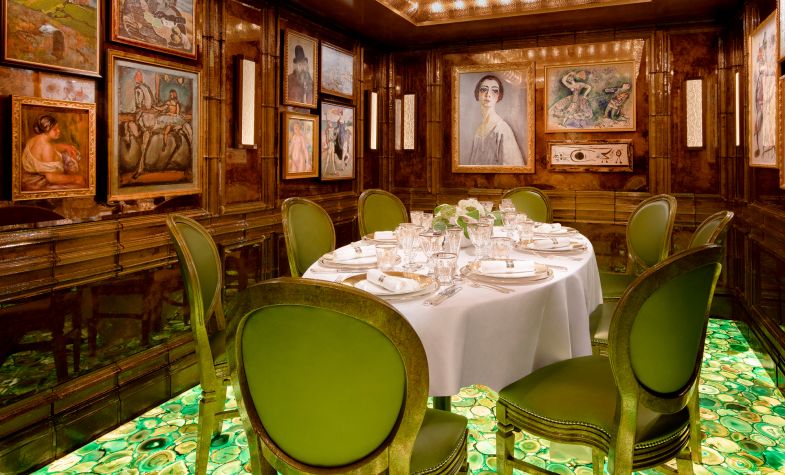 Fleming also loved the Italian food at Quo
Vadis (below) on Dean Street, where
once Karl Marx rented two small rooms in the
building. He also liked the fusty
old atmosphere of the Savoy Grill in the Savoy Hotel
(1889), where he once took
Sean Connery to lunch, and which is mentioned in
several 007 novels and the
short story “Quantum of Silence.” In 1955 Fleming
took
Fleming also loved the Italian food at Quo
Vadis (below) on Dean Street, where
once Karl Marx rented two small rooms in the
building. He also liked the fusty
old atmosphere of the Savoy Grill in the Savoy Hotel
(1889), where he once took
Sean Connery to lunch, and which is mentioned in
several 007 novels and the
short story “Quantum of Silence.” In 1955 Fleming
took 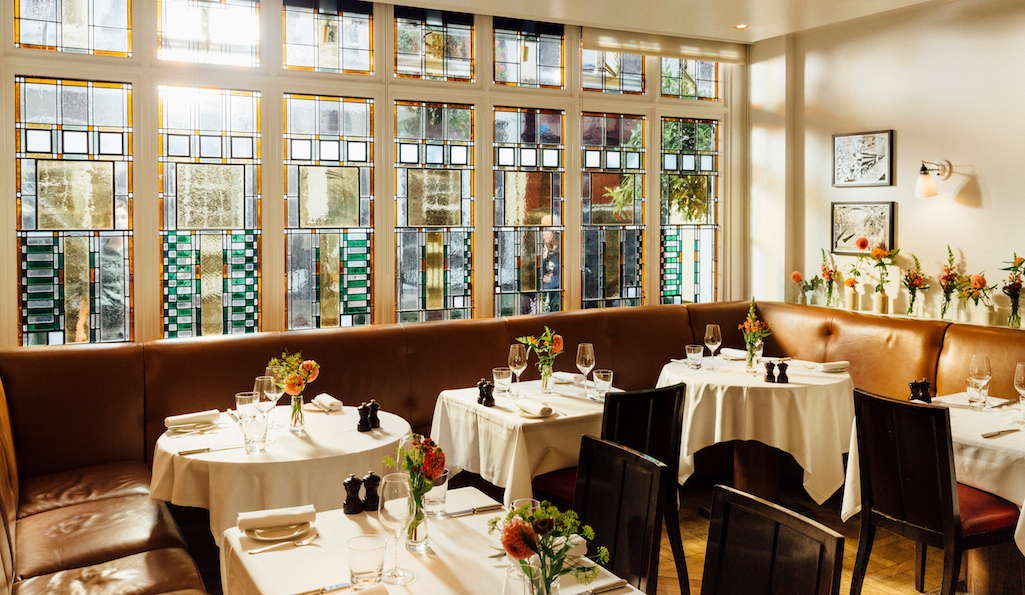 American mystery writer
Raymond Chandler, then living in Eaton Square, to
dine at Overton’s on Terminus
Place, after Chandler gave a fine blurb for the
cover of To Live
and Let Die.
American mystery writer
Raymond Chandler, then living in Eaton Square, to
dine at Overton’s on Terminus
Place, after Chandler gave a fine blurb for the
cover of To Live
and Let Die.
Haute cuisine of a kind men like Fleming and
Bond might find only in the
Paris of the 1950s and at La Gavroche in London,
which opened three years after
Fleming died, did not appeal to them, which perhaps
says something about the
British reserve that the author bred into his
fictional spy.
❖❖❖
THE LEOPARD AT DES ARTISTES
By John Mariani

A few months
ago I wrote in this column that Il Gattopardo,
across from the Museum of Modern Art, was
currently the finest Italian
restaurant in New York. Now, I want to fudge on
that claim, not because it has
been superseded by another restaurant but
because it has its equal at The
Leopard at Des Artistes near Lincoln Center. My
sophisticated readers will
catch on fast that Il Gattorpardo means
“leopard” in Italian, so it is no
stretch to realize that both restaurants are
intimately related by the ownership
of Gian-Franco and Paula Sorrentino and have
been for some time.
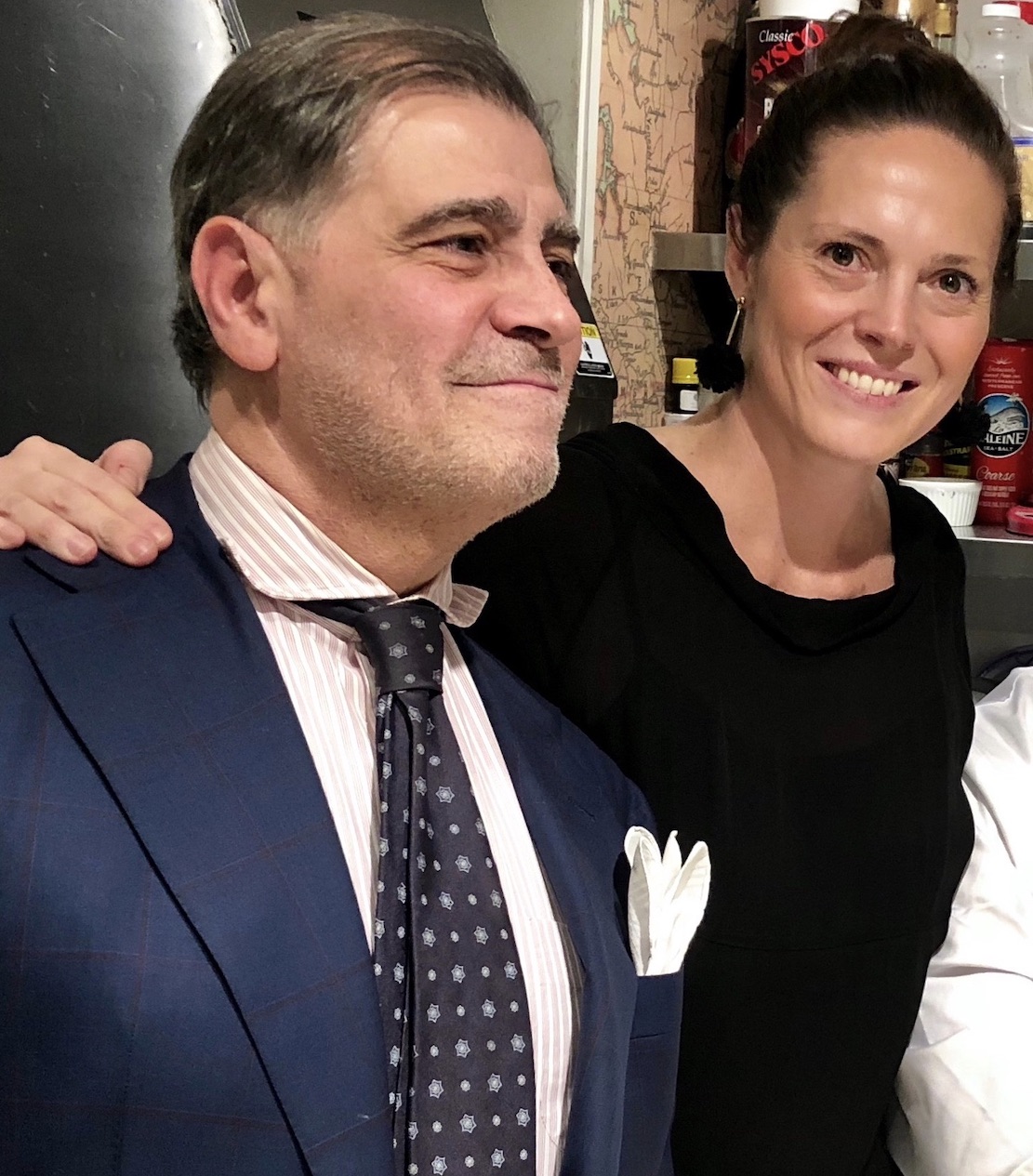 Yet, despite
their equal excellence, the
two restaurants are quite dissimilar, especially
since The Leopard has a
terrific new chef, Jordan Frosolone, while Il
Gattopardo’s continues on with
the redoubtable Vito Gnazzo, who had previously
been the chef at The Leopard.
Both men have the command of Italian classic
cuisine but with different
Yet, despite
their equal excellence, the
two restaurants are quite dissimilar, especially
since The Leopard has a
terrific new chef, Jordan Frosolone, while Il
Gattopardo’s continues on with
the redoubtable Vito Gnazzo, who had previously
been the chef at The Leopard.
Both men have the command of Italian classic
cuisine but with different
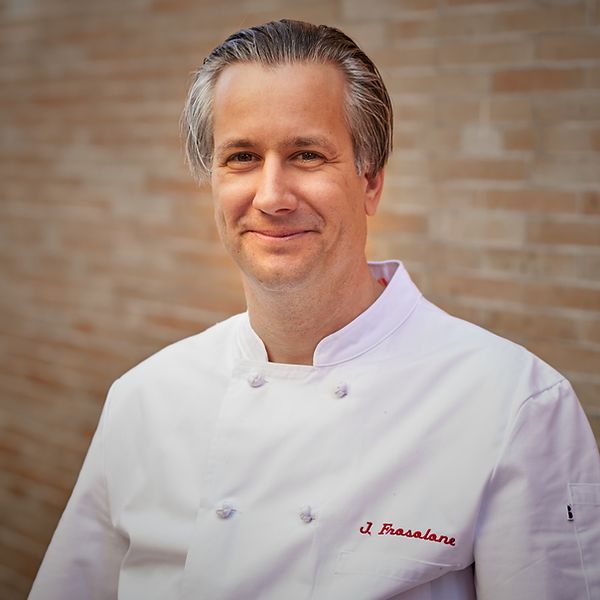 approaches:
Gnazzo’s cooking is proudly Southern, Frosolone’s
is resolutely
Northern. It makes for an enormous range of dishes
between the two of
them.
approaches:
Gnazzo’s cooking is proudly Southern, Frosolone’s
is resolutely
Northern. It makes for an enormous range of dishes
between the two of
them.
The Leopard is located within the
Hôtel des Artistes, whose rich history dates to
when it was a residence full of
opera singers, musicians and artists, which
included Howard Chandler Christy,
the man nationally famous for his wholesome
“Christy girl” cover art, but in
New York also known for his risqué 1930s murals of
36 young women romping in
woods that look a lot like Central Park, gaily
swinging on vines, dancing
rapturously or showering under a waterfall, all of
them decidedly in the buff.
Those murals are arrayed throughout The Leopard in
a beautifully lighted,
two-tier dining room that enhances the artwork.
Everything else does, too, from the thick
linens and various wineglasses
on the table to the very comfortable chairs and the space between
tables.
Service-wise, Sorrentino has a staff of long-time
professionals and some
youthful ones who make dining an exercise in
genteel hospitality.
very comfortable chairs and the space between
tables.
Service-wise, Sorrentino has a staff of long-time
professionals and some
youthful ones who make dining an exercise in
genteel hospitality.
The wine list is excellent, built around
artisanal wineries, not least
in the white wine selections, which include a
superb Fiano/Pallagrello
2018 “Polveri della
Sgarrupata” Nanni Cope’, a
Moscato
di Noto “Muscatedda” 2019 Marabino and a
Per’èPalummo 2016 “Vigna dei Mille
Anni” Casa D’Ambra.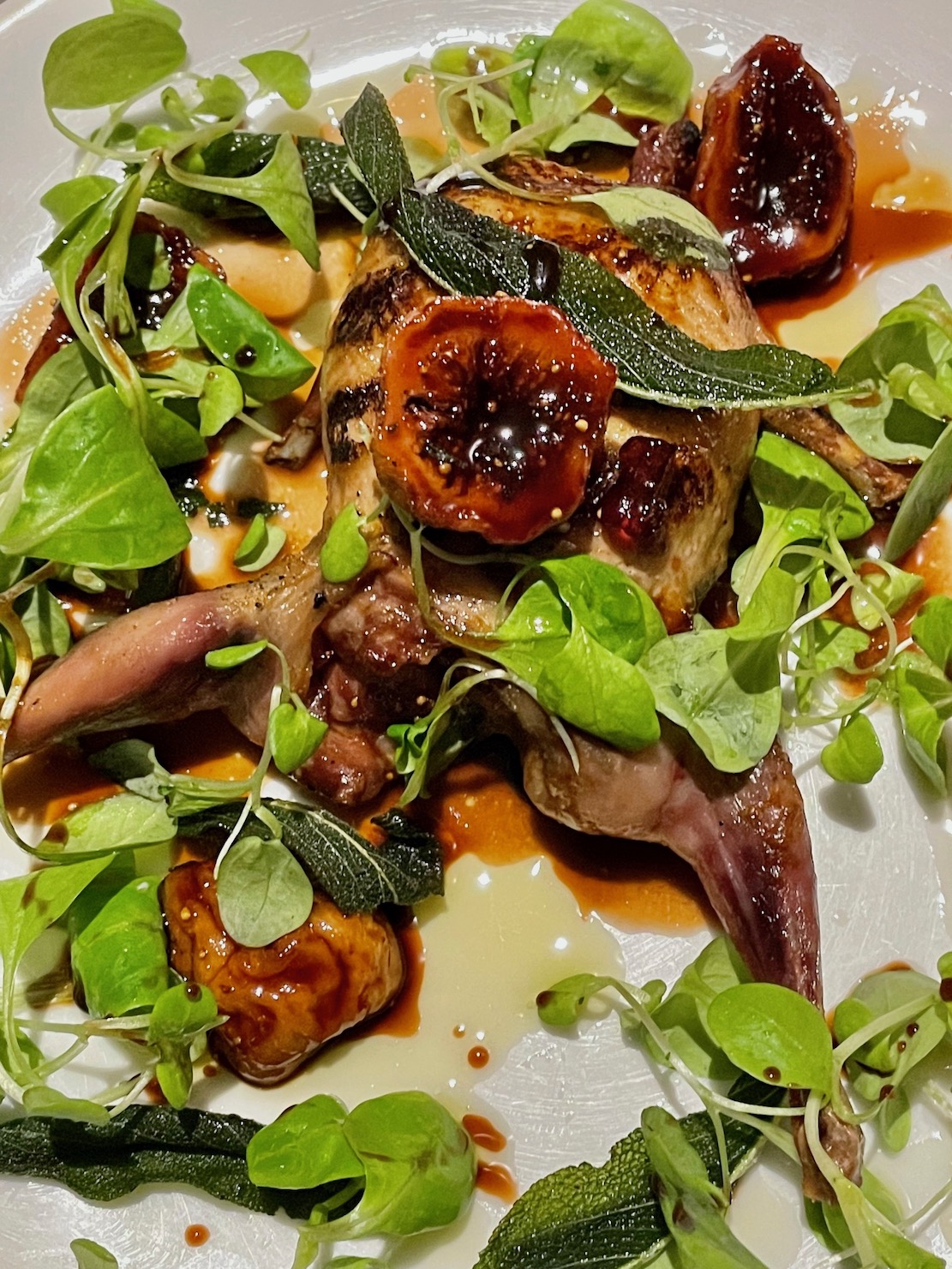
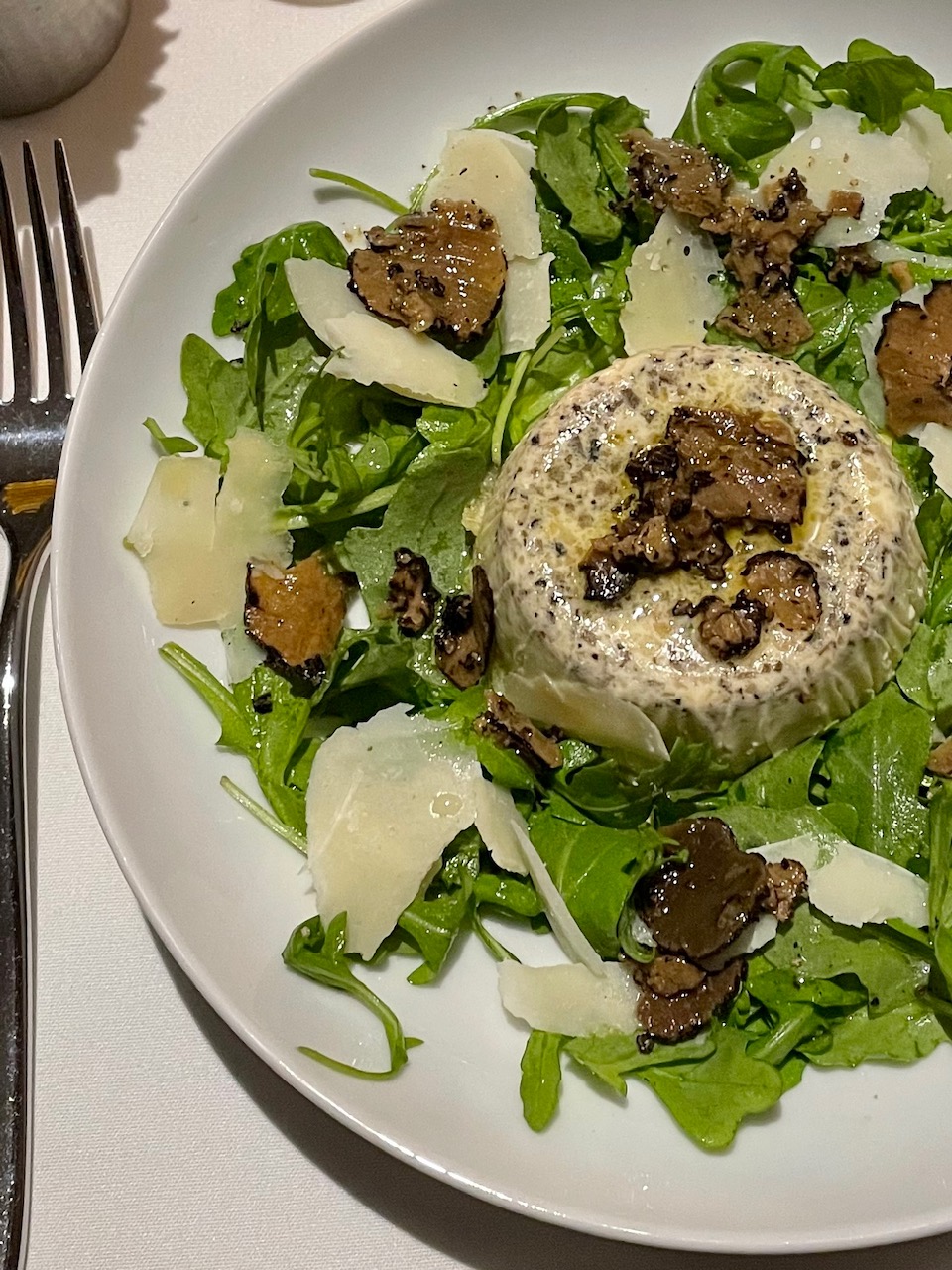 Leaving
the menu up to Frosolone, our party
of four began with a crisp pecorino and egg
croquette
scented with garlic and basil ($24), and
a peppery mixed chicory salad with
prosciutto di San Daniele and
aged montasio cheese breadcrumbs ($24). Luccio (pike) was marinated in a
white wine vinaigrette with fennel
and quickly fried capers ($27). Particularly
delightful as an antipasto was a
creamy sformato tart (left) of
baked parmigiano Reggiano with black
truffle shavings
and arugula ($27). Although served as an
appetizer, the quail (right) stuffed with
pork
sausage with red wine poached figs and crispy sage
($28) could serve as an
ample main course.
Leaving
the menu up to Frosolone, our party
of four began with a crisp pecorino and egg
croquette
scented with garlic and basil ($24), and
a peppery mixed chicory salad with
prosciutto di San Daniele and
aged montasio cheese breadcrumbs ($24). Luccio (pike) was marinated in a
white wine vinaigrette with fennel
and quickly fried capers ($27). Particularly
delightful as an antipasto was a
creamy sformato tart (left) of
baked parmigiano Reggiano with black
truffle shavings
and arugula ($27). Although served as an
appetizer, the quail (right) stuffed with
pork
sausage with red wine poached figs and crispy sage
($28) could serve as an
ample main course.
Then came wholly unusual, generously
proportioned
pastas: Struncatura
multigrain spaghettoni abundant with
shrimp, neonata
(tiny fried fish) and a squirt
of lemon ($32); Mafalde made
with
chestnut flour was typical of Alto-Adige with
mixed mushrooms, glazed chestnuts and aromatic
thyme—perfect for autumn ($32); hefty but delicate
gnocchi of
potato was tossed with jumbo lump crab meat,
scallions and the 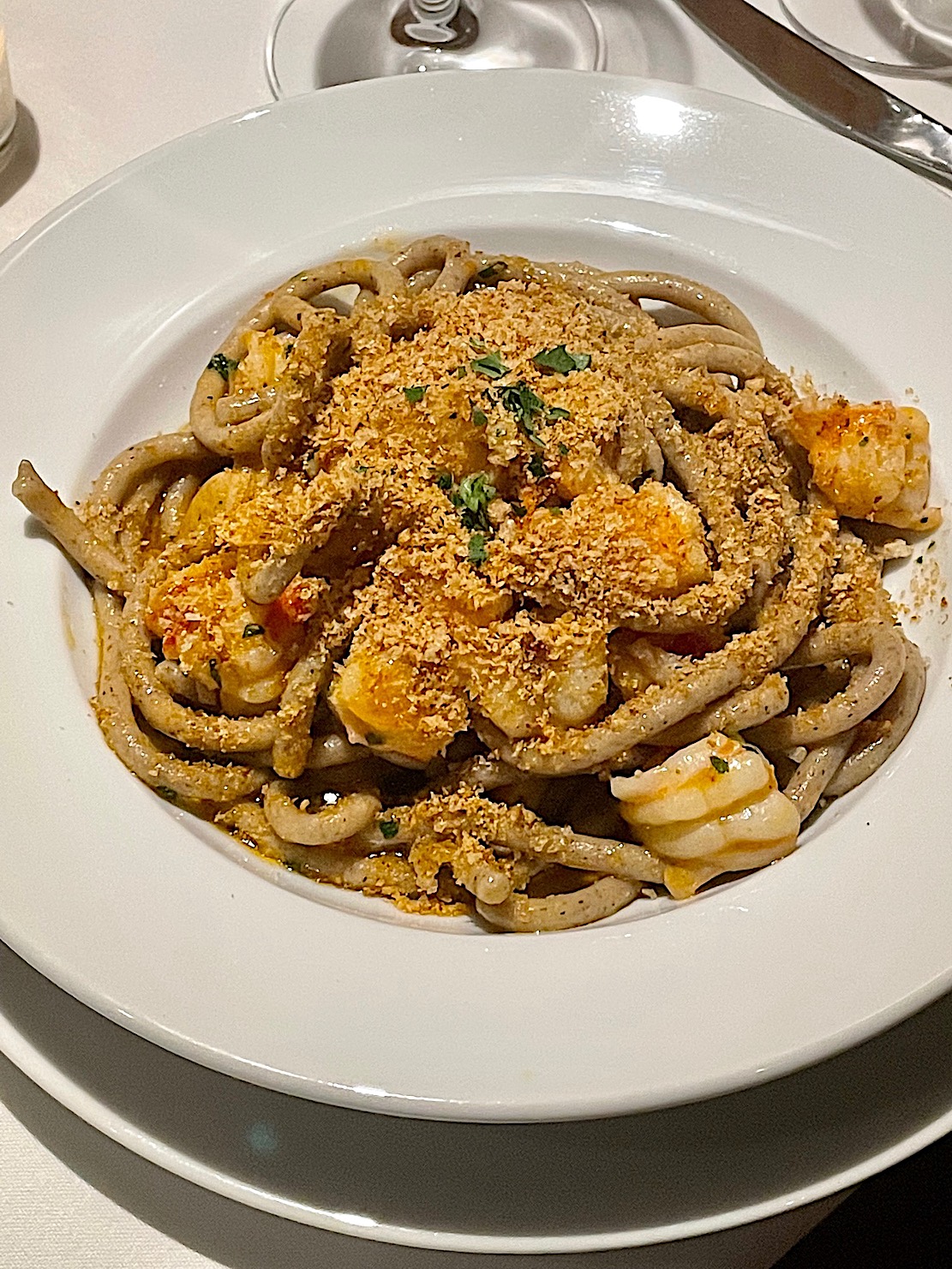 tang of lemons
($36); and one big raviolo was stuffed with beets,
poppyseeds, and sauce with
brown butter and sage ($30).
tang of lemons
($36); and one big raviolo was stuffed with beets,
poppyseeds, and sauce with
brown butter and sage ($30).
Frosolone is expert in rendering the food
at exactly the right cooking
stage, and the salmerino (sea trout) came roasted
with charred scallions, salty
trout roe and a splash of balsamic vinegar ($52);
scallops were seared and
sided with squash purée, a pancetta vinaigrette
and a touch of sage ($58).
The Leopard serves a massive grilled veal
chop with the addition of
tender roasted sweet breads, mushrooms and a rich,
heady reduction of marsala
wine ($60), while duck breast is roasted pink and
served with fall’s chestnuts,
pears and spinach ($55).
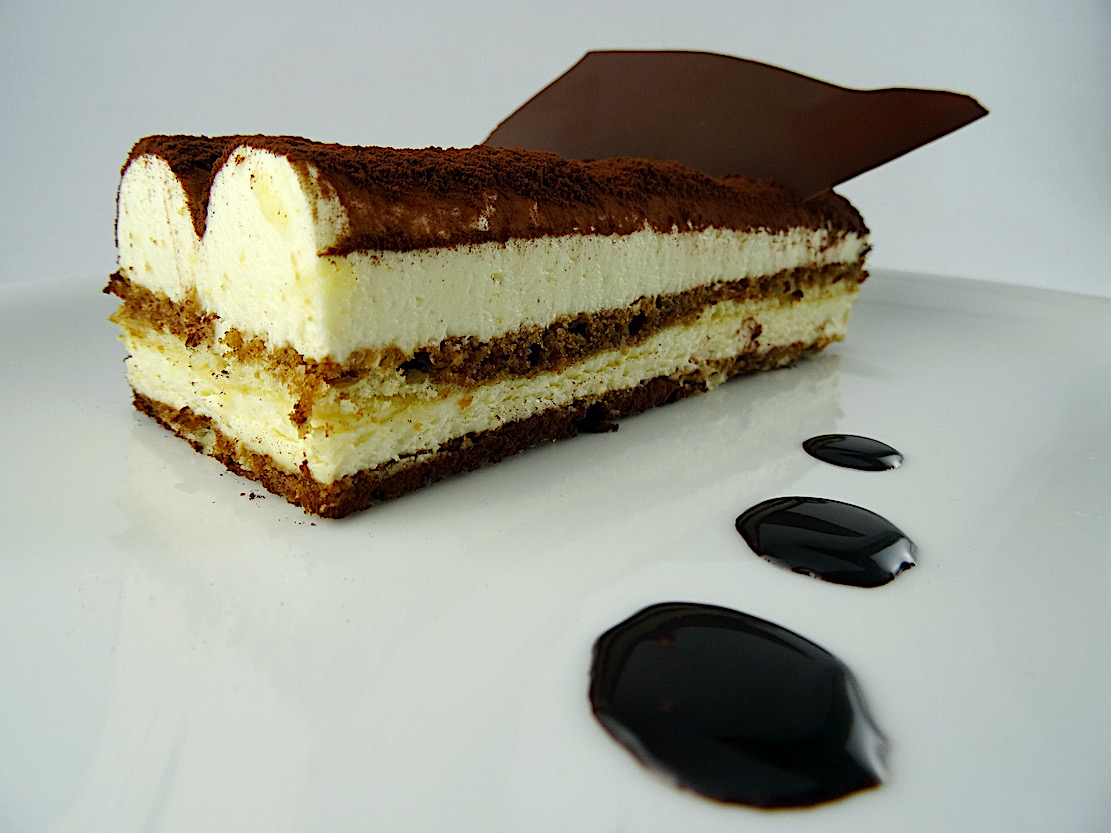 Desserts are quite traditional, but also
out of the ordinary, so that zabaione al
Ramandolo with seasonal
fruits ($20); panna cotta
with dried
figs ($17); a dark chocolate mousse with white
chocolate and orange ($17); and
a classic mascarpone tiramisù
($17)
are all handled with delicacy and finesse.
Desserts are quite traditional, but also
out of the ordinary, so that zabaione al
Ramandolo with seasonal
fruits ($20); panna cotta
with dried
figs ($17); a dark chocolate mousse with white
chocolate and orange ($17); and
a classic mascarpone tiramisù
($17)
are all handled with delicacy and finesse.
The gorgeous premises of The
Leopard at des Artistes long had a draw beyond the
quality of the food in
earlier incarnations, but now, with Frosolone
at the helm it has become the finest
Italian restaurant in the Lincoln
Center area and goes head-to-head with its sister
restaurant across from MOMA.
It all depends on what you want, southern or
northern Italian cuisine; you will
get both with beauty and grand hospitality along
with food you’d need to go to
Italy to find.
The
Leopard at des Artistes is open nightly for
dinner.
CAPONE’S GOLD
z
CHAPTER
TWENTY-EIGHT
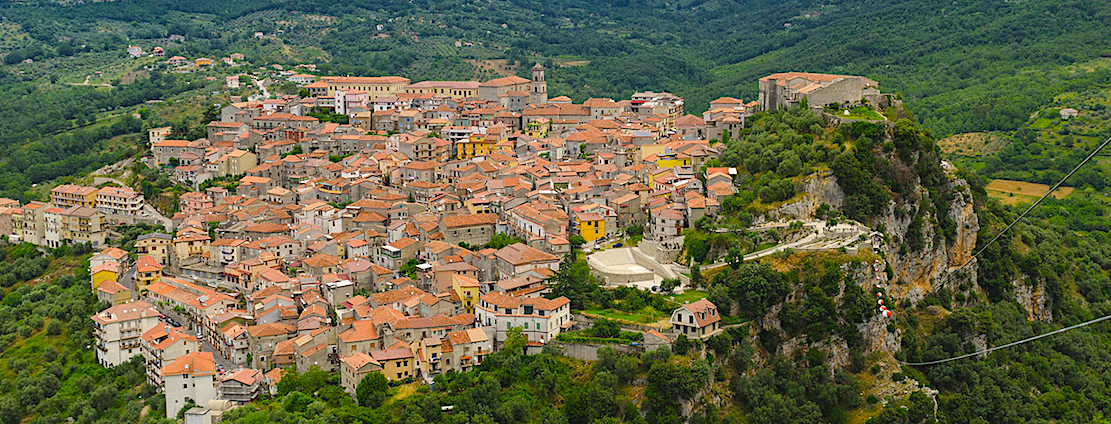
Having no idea
how much time she and David would spend digging
in Naples, Katie kept her
travel plans and return flight loose.
Since she’d never been to Naples, she
wanted to get to know it for
background color and for her own education.
Her grandparents had been born in a hill
town named Laurino, south of
the sprawling capital of 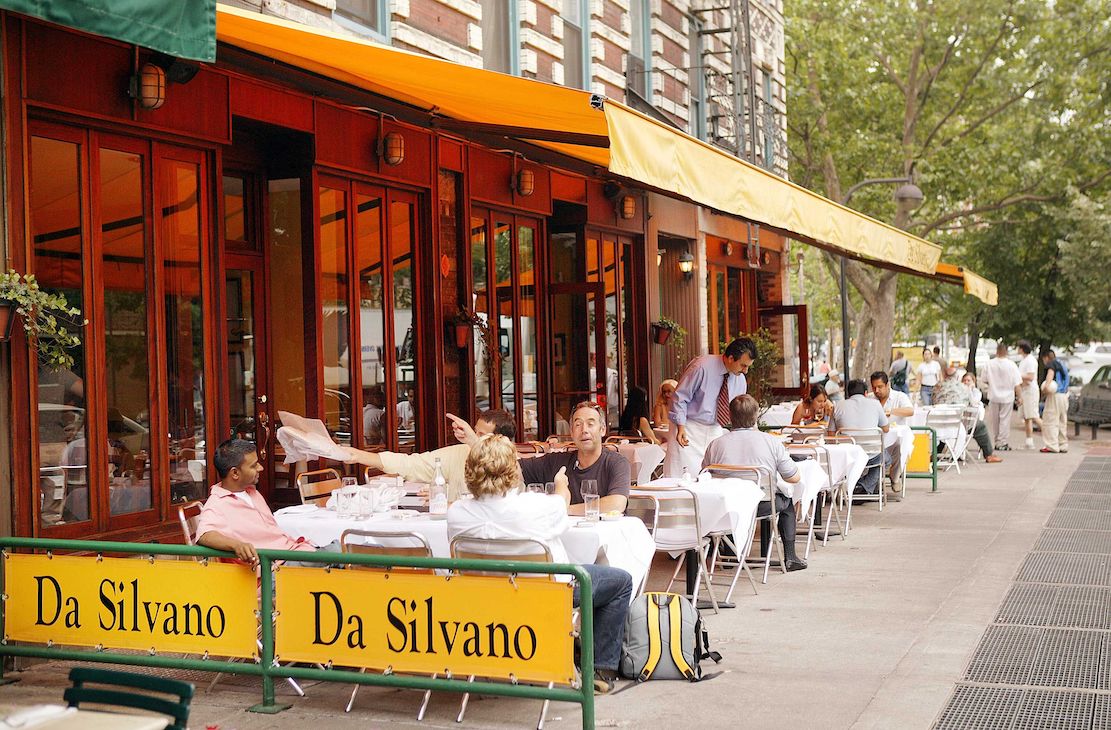 Campania, and her
parents had visited on their
honeymoon.
Somehow Katie had never
gotten around to visiting Naples, though she had
picked up a good deal of the
local dialect from her grandparents and hoped to
use it to good effect upon
arrival.
Campania, and her
parents had visited on their
honeymoon.
Somehow Katie had never
gotten around to visiting Naples, though she had
picked up a good deal of the
local dialect from her grandparents and hoped to
use it to good effect upon
arrival.
On Thursday
she met with David at her apartment. This time,
David looked around the rooms
with the eye of a detective for any random clue of
whether her date a few
nights before had left traces of his relationship
with Katie. A razor in the
bathroom.
Hairs in the bathtub. He
found nothing and felt embarrassed.
“So how’d your
date go?” he asked, with slight emphasis on the
word “date.”
Katie didn’t
even look at him, fidgeting with some papers.
“Fine. Had a
good time.”
“Where’d you
eat?”
“Da Silvano in
Greenwich Village.”
“Far cry from
Mario’s,” said David.
Katie looked
up at him and said, deadpan, “Can we get to work?
I have all the travel
arrangements. We leave Saturday, direct to Naples,
get in around eight a.m.,
check into the Angioino Hotel (below) in
the city center, near the harbor. Got a
very good rate through my travel agent,
since I booked two rooms. You know
it?”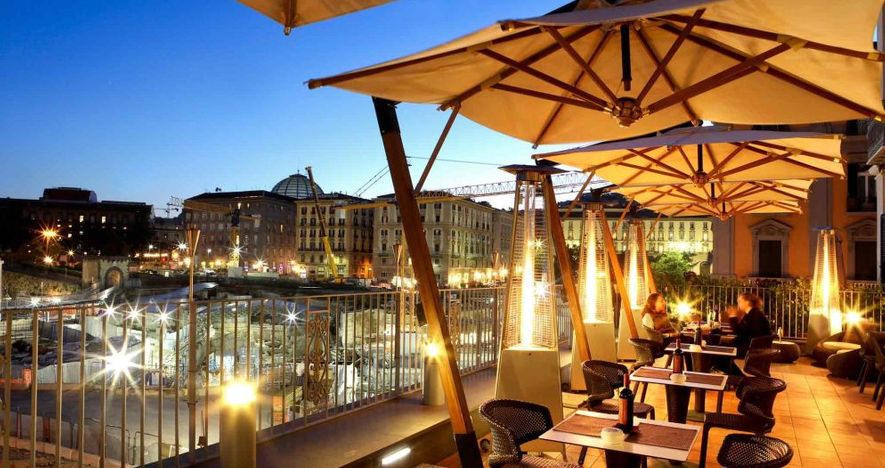
“No, but it
sounds fine. I always stayed at the Ambassador I (below),
right across from Police
Headquarters. I’ve already put in some calls to
the guys I used to work with
over there.”
“What’d you tell
them?”
“I
told them I
was retired and was helping you with this story,
and maybe they could give me
some leads.”
“What’d they
say?”
“They were
terrific. They
said they’d love to see
me again and meet you—I told them you were bellissima—and
if
we don’t find the gold at least we’ll find some
great restaurants.
You can imagine that cops in Naples eat
very,
very well.”
“Did you ask
them about this guy Iacobello?”
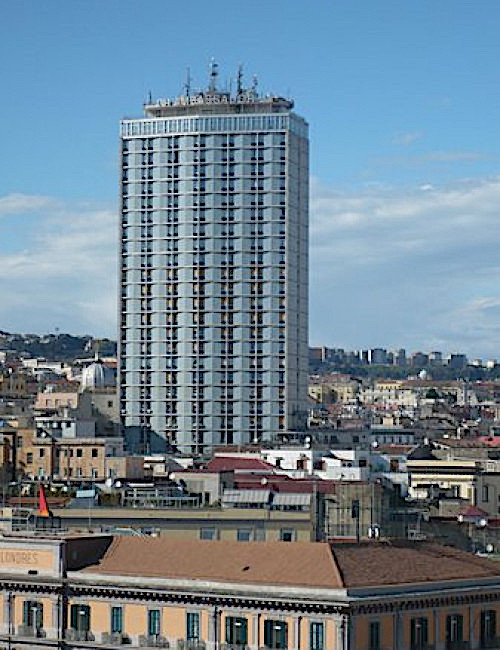 “I did, after
I called my contact in Philadelphia. They had a
rap sheet on him and confirmed
that he had been deported and they’d washed their
hands of him. My Naples
contact said they knew him as a washed-up mobster
who beat the rap over there
and was living quietly. They knew where he was,
but other than that they kept
no particular tabs on him because his name never
came up during investigations
of the Camorra mob. They said he lived modestly
with his wife in Spaccanapoli—I
told them the address I got from Frascella and it
seems to be correct. No
evidence he had any gold ingots stashed in his
apartment.”
“I did, after
I called my contact in Philadelphia. They had a
rap sheet on him and confirmed
that he had been deported and they’d washed their
hands of him. My Naples
contact said they knew him as a washed-up mobster
who beat the rap over there
and was living quietly. They knew where he was,
but other than that they kept
no particular tabs on him because his name never
came up during investigations
of the Camorra mob. They said he lived modestly
with his wife in Spaccanapoli—I
told them the address I got from Frascella and it
seems to be correct. No
evidence he had any gold ingots stashed in his
apartment.”
“Okay, then,” said Katie. “How about we
meet at JFK around six? The flight’s at eight.”
“Sounds good.
See you then.”
As David
drove home along the Hudson he couldn’t help
thinking Katie had been a little
chilly with him earlier. Whenever
they’d
been together doing interviews in Miami, New York
and Annapolis, he felt they
were becoming real friends, and he’d begun to care
a lot about her.
He assumed Katie’s new demeanor was due to
his asking too many questions about her date with
some unknown guy, the kind
who would take her to Da Silvano, which was known
to be a hangout for the art
gallery and fashion crowd.
Somehow—childishly, he said to himself—he
thought that Katie would have
no interest in such places, being a Bronx girl and
all, taking him to Mario’s
for dinner. Then again, he himself had moved out
of the Bronx and didn’t feel
much a part of it anymore. Which is why it felt
good to get back to it with
Katie.
Up until that
moment David hadn’t felt Katie was out of his
league, or age range, but now
that’s exactly what he began to feel.
Well, he thought, soon they’d be on a plane
together, in the same hotel,
restaurants, on the trail again, a team.
And although he was still interested in
finding Capone’s gold, the
thought of just being with Katie for an extended
period in Italy made him feel
better.
*
*
*
On the cramped
plane ride over Katie and David had middle seats,
with no room to spread out
any papers. And
they’d agreed not to
talk about the case, just eat and try to fall
asleep at a regular time. They
looked forward to the good espresso and pastries
upon arrival in Naples.
Still, Katie
thought David was oddly quiet, so she asked him
about aspects she hadn’t yet
pried into.
“Did
you ever
want to be anything but a cop?” she asked.
“Of course.
Every kid growing up in New York wanted to play
professional baseball. I
actually thought I had talent, but
apparently not enough. I didn’t have the interest
required to go to a four-year
college and my father’s life as a cop was a pretty
good one. So I joined the
force. Only later did I decide my best instincts
would be on the detective
squad going after the wise guys.”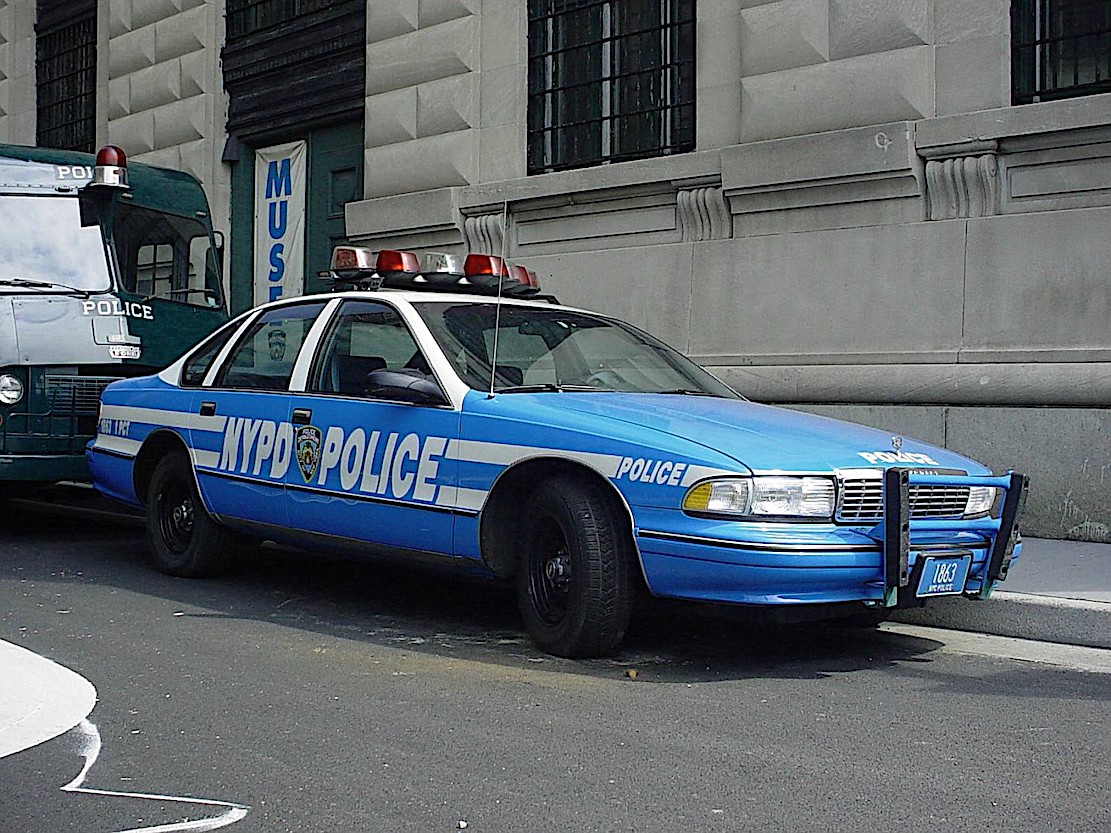
“But you’d
been a cop on a beat?”
“Squad car.
Had a whole series of partners, and as I got older
they got younger.
I wasn’t much of a mentor and I had no use
for hotheads, which is what most of them are now. I mean,
what is with these guys shaving their
heads, just to look like, what? Bruce Willis in
Die Hard? I can’t tell you how
many times I had to pull a rookie off a guy he was
beating the shit out of.
People say, ‘Yeah, being a cop is tough and they
face danger and possible death
every day they go out.’” David
shook his
head.
“What’s the
truth of it?”
“The truth is
that too many guys go looking for trouble, start
trouble, get themselves into
dangerous situations where they don’t exist. When
I was coming up we thought we
were out there to ‘keep the peace,’ not stir up
trouble. Law enforcement means
making sure the laws are being obeyed; it doesn’t
give a cop license to go
after anyone that looks vaguely
suspicious—especially if he’s black. This
‘stop-and-frisk’ is total bullshit. It’s not good
police work and it totally
antagonizes the neighborhood, makes cops look like
the bad guys, and a lot of
them are.”
“Did you ever
have to pull your gun?”
“Couple of
times. Just to make sure the bad guys knew I had
it ready.” David
knew what was coming next.
“So . . . you
never shot anyone?”
David shook
his head again. “No, I never shot anyone.
And ninety percent of the cops I worked
with never shot anyone. Most
never even pulled out their guns. That’s changed. Cops are
getting way too eager these days to
shoot at the slightest sign of opposition. And I
mean shoot to kill, not to
wound, not to disable. Now you shoot for the head
and chest—that’s what the
current training says. Boom, boom, boom! You empty
the whole goddamn clip into
the guy. What
I was taught was that
you’re supposed to avoid that at all costs, try to
calm things down first, make
no assumptions but be aware the guy may have a
weapon. But even if he shows it,
you first try to get him to put the freaking thing
down. You
tell him the consequences, which are that
the cops will blow him away in about two seconds. Most of
these guys on the street, even the
ones drugged out of their minds, know they do not
want to shoot a cop,
especially because there’s usually a bunch of us
on all sides of the sucker.”
David took a
sip of the bad wine he’d been served and stuck his
fork into the wretched looking lasagna
in front of him.
“It’s very
different now, Katie. I’m glad I’m out of it,”
then he said, “But I have to
tell you, I’m glad I’m here with you. I
feel. . . some of the old thrill of the chase.
We’ll have some fun in Italy. And good
food and wine, too.”
David didn’t
know what response he’d receive from Katie, but
she squeezed his arm and said,
“I’m all in for that!”
Her smile was
genuine, thought David. An hour
later
Katie was asleep on his shoulder, and David leaned
his head on hers.
© John Mariani, 2015
❖❖❖
BURGUNDY'S 2021 VINTAGE
AND THE STATE OF THE GLOBAL MARKET
By John Mariani
The
most prestigious
vineyards and producers in Burgundy, like those of
the Côte d’Or,
never have any problem selling every bottle
they can produce, but the rest of Burgundy—which
has a range that goes from
Chablis to Beaujolais—must compete with the
increasing panoply of wines every
year in the global market. To find out about the
2021 harvest and how things
are going generally in the Burgundy region I spoke
to Frédèric Drouhin,
President of the Bourgogne Wine Board (below).
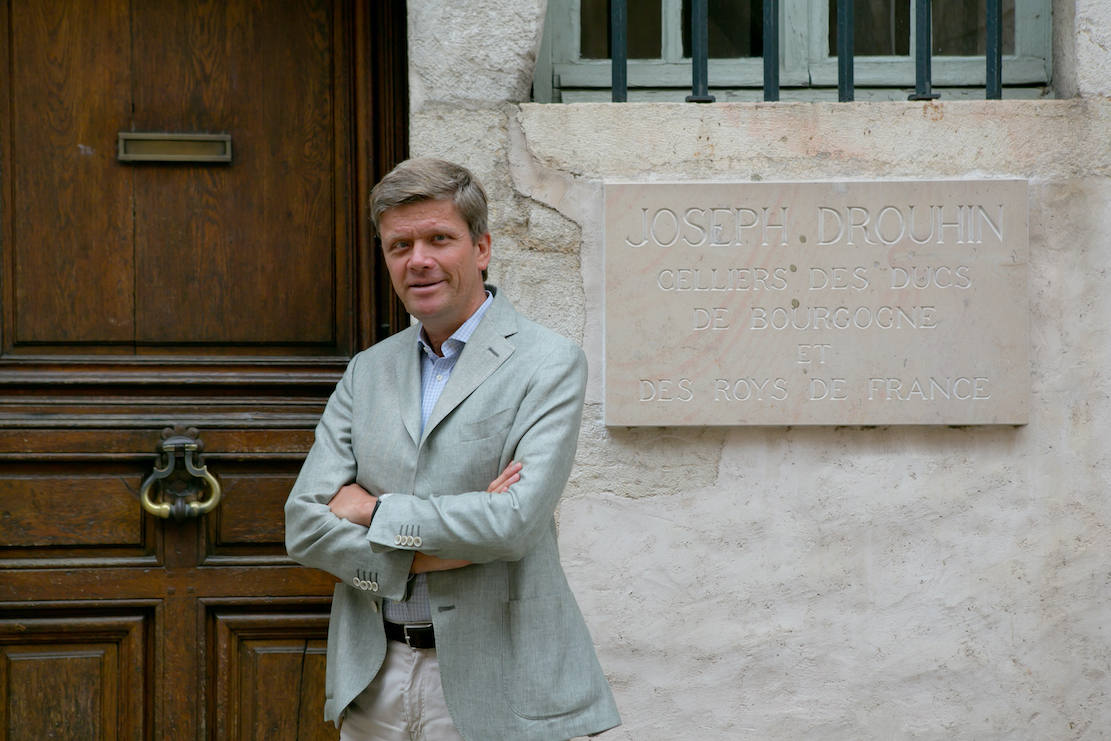
Can
you give me a general overall
picture of the 2021 harvest?
Harvesting mainly took off across
Bourgogne between 18-20
September, after a trying year punctuated by
challenging weather events. The
Crémant de Bourgogne (sparkling wines) started
earlier. The very first grapes
were picked on September 8, but most of the
producers started on the 10th. Pinot Noir
grapes were ready earlier than
Chardonnay, which is unusual. Chardonnay was delayed
after the April frost. It
took a few weeks before the vines were able to
resume their growing cycle.
Sorting
was sometimes
necessary and, as almost all domains and négociants
are very well equipped, it
was not an issue. Fermentations have begun rather
quickly, both for the whites
and the reds, proving that the population of yeast
was quite active. Today
devatting has begun and the first tastings are
positive.
Was
it a difficult year in other
parts of France’s vineyards?
Yes. Nearly all wine regions in France
suffered from the April
frost. Some regions also suffered from rainfalls
that provoked sometimes
oïdium, mildew or hail. The French government
declared the total volume of wine
in France could be down 28 to 32% in 2021, but we
don’t know how much will be
lost. We will have a first idea in November. We are
now carrying a field survey
by collecting the results of at least 400 producers.
On Nov. 21, at the
Hospices de Beaune wine auction press conference, we
will be able to give a
first estimation of our volumes. The final figures
will be available in
February 2022.
With
global warming in vineyards,
can you discern any effect in this year’s harvest?
This year, if you leave aside the
consequences of the frost, not
really (we had the coolest month of July in 50
years!). Frost in April is quite
usual in Bourgogne. The problem mostly comes from
the mild winters. We have
seen a 1°C rise in average temperatures since 1987.
Various studies suggest
that the growth cycle of the vines has been
happening earlier since 1988.
Flowering has occurred on average two weeks earlier
since that date, compared
to the period 1961-1987. This explains why the frost
in April is now a risk
that we have to be aware of. On the other hand, this
advance helps us get a
good maturity every year.
Was
there a lack of sun and heat
to build up the sugars?
Indeed, the average monthly
temperatures and average monthly
sunshine have been under the normal, at least from
early July to mid-August.
Afterward, the last 2 weeks of August and first 2
weeks of September have been
sunny, which helped complete the maturity. This
explains why we are back to the
traditional delay of 100 days between flower and
harvest (last year, we were
more around 90-92 days). We are reaching normal
level of sugar and acidities
(lower than in recent years), which may occur of a
typical Bourgogne vintage,
with lovely freshness.
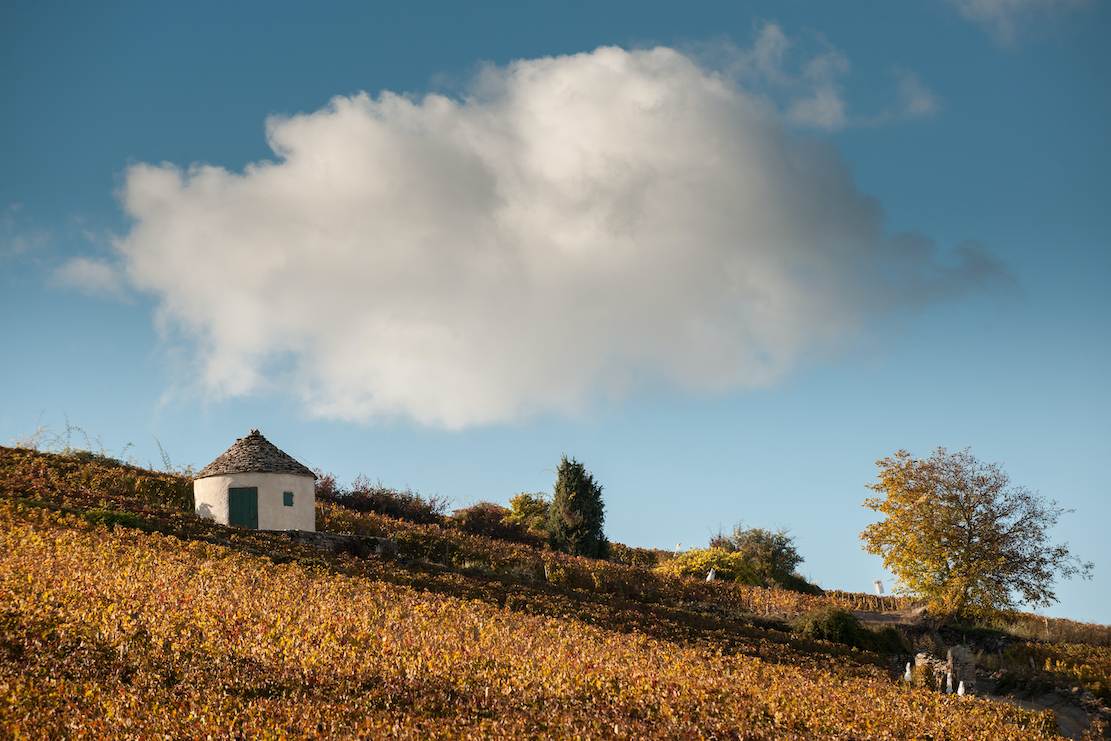 Are
increasing alcohol levels in
Bourgogne a concern in the future?
Are
increasing alcohol levels in
Bourgogne a concern in the future?
Until now, rising temperatures have
been a bonus for Bourgogne
wines. Bourgogne has a cool climate, and,
traditionally, we were harvesting in
October, with low level of sugars (chaptalization
was the annual rule then).
Regardless of the varietal, the global warming has
been improving balance in
terms of potential alcohol, acidity, and so on. The
two main varietals of Pinot
Noir and Chardonnay are now found in much hotter
wine growing regions than
ours, and the Bourgogne Wine Board is currently
studying the behavior of these
varietals in other warmer regions. Our aim is to
establish how much these
varietals are able to adapt to a changing climate,
and thus anticipate what
adaptations might occur. With the 2021 vintage we
are back to a classic style
with a lovely expression of fruitiness, balance,
freshness, and lower level of
alcohol.
Can
you tell me what the Cave de
Prestige des Vins de Bourgogne is intended to
accomplish?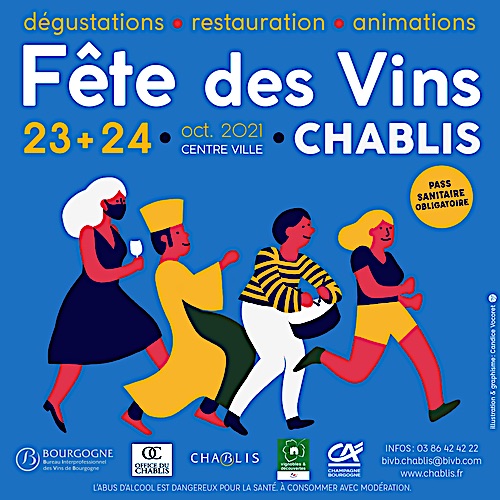
The Cave de Prestige selection is now
both a tool and a real
showcase for Bourgogne wines. First, the selection
process is very rigorous:
Only 12.85% of the samples were selected this year
(203 out of 1,580). This
rigor is essential. We (the Bourgogne Wine Board)
will use them for all
training, promotional, and marketing activities over
the next 12 months. Those
wines will remind people how Bourgogne has a truly
extensive offer that goes
far beyond a few iconic names. They must represent
all the excellence of Bourgogne
wines, whatever the level of AOC.
The Fête
des Vins de Chablis
2021 is coming soon. Can you tell me about
that event?
Since its first edition in 1949, the
Fête des Vins de Chablis
continues to evolve, but its success is
always based on a single notion: Conviviality! On
23 & 24 October, the town center will once again
be hosting
a wide range of
events featuring the
vines of Chablis and the wider Grand Auxerrois
region. The festival is
organized by the Office du Chablis in partnership
with the Bourgogne Wine
Board.
We are awaiting 4,000
to 5,000 visitors. Each of them can buy the
dedicated Glass (6€): afterwards,
all the wine tastings are free. On Saturday, there
is the Marathon de Chablis;
on Sunday morning, there is a walk in the vineyards,
with departure every 15
minutes. If you prefer, there will be a Bourguignon
market everywhere in the
streets with local products. Forty producers will
show their wines. The list
will be available mid-October.
Everyone will have to
show a “pass sanitaire” proving vaccination or
Covid-free status. Then, you can
do the walk-in with no mask.
.jpg) Can
you tell me more about the
progress on La Cité des Vins et des Climats de
Bourgogne (above)?
Can
you tell me more about the
progress on La Cité des Vins et des Climats de
Bourgogne (above)?
2021 marked the official launch of the
three worksites in Mâcon,
Beaune, and Chablis. The content will be gradually
augmented with opening dates
set for 2022 and 2023.
The other major point
of 2021 is the final definition of name and image:
It will be known to the
world as Cité des Climats et vins de Bourgogne. The
notion of “Climat” now
comes first, to remind the world the Bourgogne is
where the notion of terroir
was pushed to its maximum. The three sites in the
Cité des vins et des Climats
de Bourgogne network each have different dimensions
and timescales, with work
beginning at different points during 2021. This was
preceded by the symbolic
laying of the first stone in the presence of partner
public bodies. Regarding
content, work has been accelerating as the
definition of the content and
services proposed in each location is widened out,
from visitor trails to
wine-themed activities, one-off events, stores,
wine-themed tips and advice,
private hires, a discovery bar, workshops, tasting
classes and training from the
École des Vins de Bourgogne.
How
is the global market for the
high-end crus like DRC?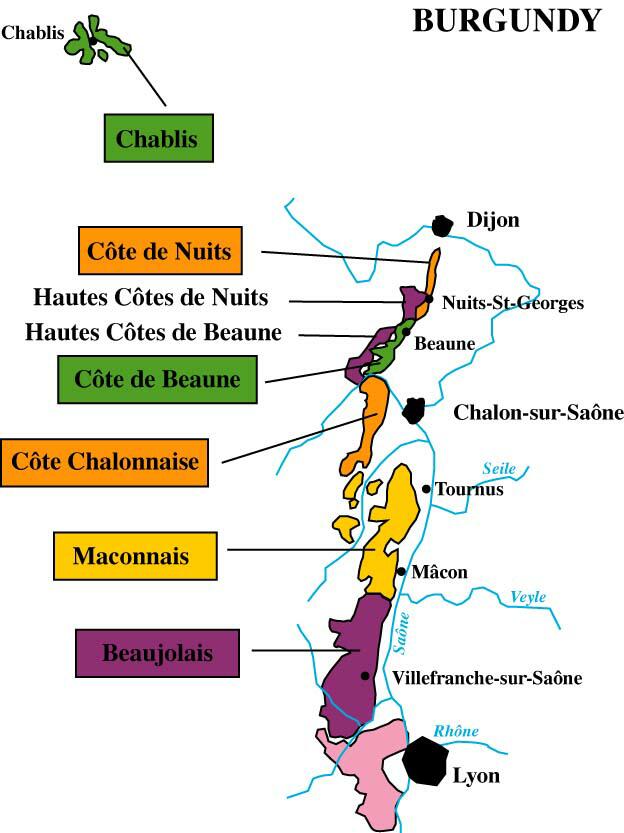
As a whole, Bourgogne wines are performing very well this year. In the first seven months of 2021, the exports are up 24.8% (number of bottles) and up 34.3% (revenue). Figures are even better than in 2019, which was an excellent year.
2020 was also a good year, despite the pandemic. The volume of Bourgogne wines exported maintained its growth in 2020, close to the equivalent of 90 million 75cl bottles (down 0.3% on 2019). Export revenue remained above one billion euros, despite a slight drop of 0.7% on 2019. Nevertheless, in 2021, all the groups of AOCs are performing well. Concerning the high-end Premier and Grand Cru AOCs, the figures are very good:
•
White Grand Cru in Côte de Beaune/ Côte
de Nuits AOCs: up 203.6% in volumes and up 21.5% in
value
•
Chablis Premier and Grand Cru AOCs: up
76% in volumes and up 47% in value
•
Red Grand Cru AOCs in Côte de Nuits/Côte
de Beaune: up 38% in volume and
up 28%
in value
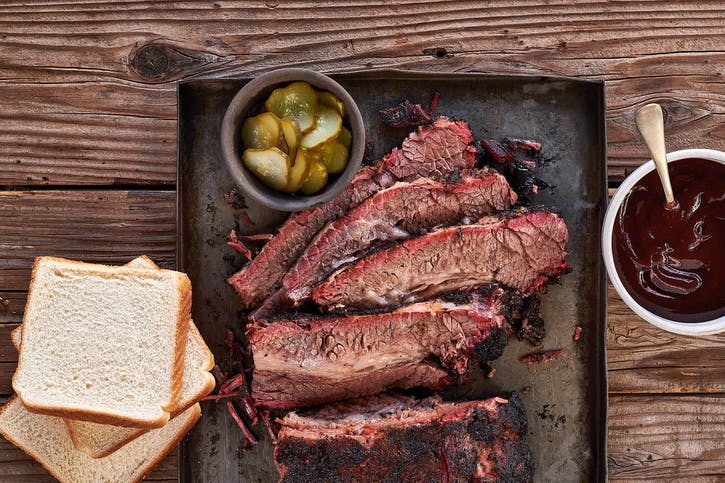 YET ANOTHER THING
WE
YET ANOTHER THING
WEDOUBT ABOUT TEXAS
"Has Texas Brisket Peaked? The state’s favorite smoked meat is so reliably excellent these days that it no longer feels like an achievement." by Daniel Vaughn, Texas Monthly (Oct 1, 2021).
 The Hound in Heaven
(21st Century Lion Books) is a novella, and
for anyone who loves dogs, Christmas, romance,
inspiration, even the supernatural, I hope you'll find
this to be a treasured favorite. The story
concerns how, after a New England teacher, his wife and
their two daughters adopt a stray puppy found in their
barn in northern Maine, their lives seem full of promise.
But when tragedy strikes, their wonderful dog Lazarus and
the spirit of Christmas are the only things that may bring
his master back from the edge of despair.
The Hound in Heaven
(21st Century Lion Books) is a novella, and
for anyone who loves dogs, Christmas, romance,
inspiration, even the supernatural, I hope you'll find
this to be a treasured favorite. The story
concerns how, after a New England teacher, his wife and
their two daughters adopt a stray puppy found in their
barn in northern Maine, their lives seem full of promise.
But when tragedy strikes, their wonderful dog Lazarus and
the spirit of Christmas are the only things that may bring
his master back from the edge of despair. WATCH THE VIDEO!
“What a huge surprise turn this story took! I was completely stunned! I truly enjoyed this book and its message.” – Actress Ali MacGraw
“He had me at Page One. The amount of heart, human insight, soul searching, and deft literary strength that John Mariani pours into this airtight novella is vertigo-inducing. Perhaps ‘wow’ would be the best comment.” – James Dalessandro, author of Bohemian Heart and 1906.
“John Mariani’s Hound in Heaven starts with a well-painted portrayal of an American family, along with the requisite dog. A surprise event flips the action of the novel and captures us for a voyage leading to a hopeful and heart-warming message. A page turning, one sitting read, it’s the perfect antidote for the winter and promotion of holiday celebration.” – Ann Pearlman, author of The Christmas Cookie Club and A Gift for my Sister.
“John Mariani’s concise, achingly beautiful novella pulls a literary rabbit out of a hat – a mash-up of the cosmic and the intimate, the tragic and the heart-warming – a Christmas tale for all ages, and all faiths. Read it to your children, read it to yourself… but read it. Early and often. Highly recommended.” – Jay Bonansinga, New York Times bestselling author of Pinkerton’s War, The Sinking of The Eastland, and The Walking Dead: The Road To Woodbury.
“Amazing things happen when you open your heart to an animal. The Hound in Heaven delivers a powerful story of healing that is forged in the spiritual relationship between a man and his best friend. The book brings a message of hope that can enrich our images of family, love, and loss.” – Dr. Barbara Royal, author of The Royal Treatment.
 |
The Encyclopedia of American Food and Drink by John F. Mariani (Bloomsbury USA, $35) Modesty forbids me to praise my own new book, but let me proudly say that it is an extensive revision of the 4th edition that appeared more than a decade ago, before locavores, molecular cuisine, modernist cuisine, the Food Network and so much more, now included. Word origins have been completely updated, as have per capita consumption and production stats. Most important, for the first time since publication in the 1980s, the book includes more than 100 biographies of Americans who have changed the way we cook, eat and drink -- from Fannie Farmer and Julia Child to Robert Mondavi and Thomas Keller. "This book is amazing! It has entries for everything from `abalone' to `zwieback,' plus more than 500 recipes for classic American dishes and drinks."--Devra First, The Boston Globe. "Much needed in any kitchen library."--Bon Appetit. |
"Eating Italian will never be the same after reading John Mariani's entertaining and savory gastronomical history of the cuisine of Italy and how it won over appetites worldwide. . . . This book is such a tasteful narrative that it will literally make you hungry for Italian food and arouse your appetite for gastronomical history."--Don Oldenburg, USA Today. "Italian
restaurants--some good, some glitzy--far
outnumber their French rivals. Many of
these establishments are zestfully described
in How Italian Food Conquered the World, an
entertaining and fact-filled chronicle by
food-and-wine correspondent John F.
Mariani."--Aram Bakshian Jr., Wall Street
Journal.
"Equal parts
history, sociology, gastronomy, and just
plain fun, How Italian Food Conquered the
World tells the captivating and delicious
story of the (let's face it) everybody's
favorite cuisine with clarity, verve and
more than one surprise."--Colman Andrews,
editorial director of The Daily
Meal.com. "A fantastic and fascinating
read, covering everything from the influence
of Venice's spice trade to the impact of
Italian immigrants in America and the
evolution of alta cucina. This book will
serve as a terrific resource to anyone
interested in the real story of Italian
food."--Mary Ann Esposito, host of PBS-TV's
Ciao
Italia. "John Mariani has written the
definitive history of how Italians won their
way into our hearts, minds, and
stomachs. It's a story of pleasure over
pomp and taste over technique."--Danny Meyer,
owner of NYC restaurants Union Square
Cafe, The Modern, and Maialino.
|
 |
 |
 |
 |
 |
 |
 Everett Potter's Travel Report:
Everett Potter's Travel Report: 
 Eating Las
Vegas JOHN CURTAS has been covering
the Las Vegas food and restaurant scene
since 1995. He is the co-author of EATING LAS
VEGAS – The 50 Essential Restaurants (as
well as the author of the Eating Las
Vegas web site: www.eatinglasvegas.
He can also be seen every Friday morning as
the “resident foodie” for Wake Up With the
Wagners on KSNV TV (NBC) Channel 3 in
Las Vegas.
Eating Las
Vegas JOHN CURTAS has been covering
the Las Vegas food and restaurant scene
since 1995. He is the co-author of EATING LAS
VEGAS – The 50 Essential Restaurants (as
well as the author of the Eating Las
Vegas web site: www.eatinglasvegas.
He can also be seen every Friday morning as
the “resident foodie” for Wake Up With the
Wagners on KSNV TV (NBC) Channel 3 in
Las Vegas.
MARIANI'S VIRTUAL GOURMET
NEWSLETTER is published weekly. Publisher: John Mariani. Editor: Walter Bagley. Contributing Writers: Christopher
Mariani, Misha Mariani, John A. Curtas, Gerry Dawes, Geoff Kalish.
Contributing
Photographer: Galina Dargery. Technical
Advisor: Gerry
McLoughlin.
If you wish to subscribe to this
newsletter, please click here: http://www.johnmariani.com/subscribe/index.html
© copyright John Mariani 2021

